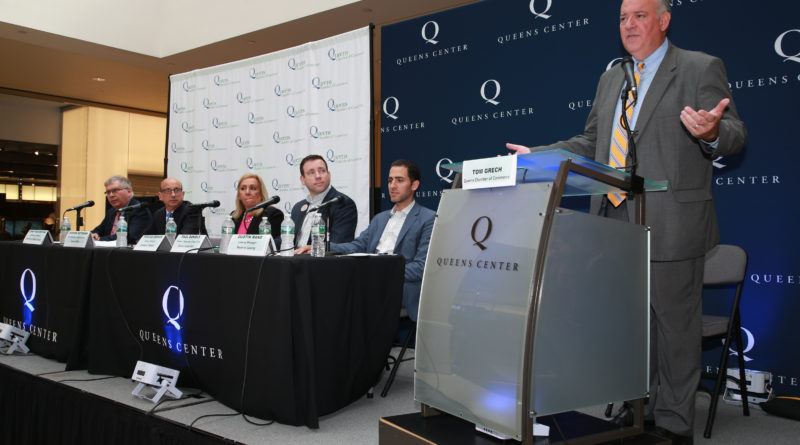Future of retail in tech and creating an experience
BY BENJAMIN FANG
Photos: Dominick Totino
Retailers today face a plethora of challenges, from Amazon and the digital revolution to ever-evolving consumer demands from millennials and Generation Z.
To discuss the future of the retail industry, the Queens Chamber of Commerce’s Real Estate Committee convened a panel of experts on June 6 at Queens Center Mall. The event offered multiple perspectives on the retail sector’s changing landscape, from store owners to real estate services firms.
Jonathan Krivine, director of retail for the firm Avison Young, said while the current environment is challenging for retailers, it’s also ripe for innovative entrepreneurs who are responding to the younger generation’s needs.
“The data is out there, we know what’s selling these days and what’s not selling,” he said. “We just have to accept reality that Amazon has raised the bar for performance in the retailing world.”
Krivine said younger consumers generally have shorter attention spans. With an option as instant as Amazon, they now evaluate the shopping experience in a store to their experience shopping online.
“You’ve got to satisfy them fast,” he said. “You’ve got to have a smile on your face if you’re selling in that store.”
It’s not just the interactions that need to change. Krivine said brick-and-mortar stores have to be more visual and digital. Companies like McDonalds and CVS are already experimenting with new technology that may eventually replace cashiers, he said.
“That’s the future,” Krivine said. “These young people, they get it. They can respond to it.”
Steven Rothman, senior vice president at the firm Jones Lang LaSalle, said if retailers want to be more profitable and draw more people into their stores, they will have to employ some of the new technologies being developed now.
Companies are already using geofencing, which is the use of GPS software to track when a mobile device enters or leaves an area. They’re using drones to deliver packages faster. They’re starting to move away from cash payments, and toward mobile payments.
Other technologies include 3D printing, virtual reality, artificial intelligence and dynamic pricing. Even driverless cars will change the way consumers purchase goods, Rothman said.
“All those trends will transform the retail industry,” he said, “not today, but over the next 10, 15 and 20 years.”
Rothman, a veteran in the retail banking field, said tech has already transformed the industry. While banks remain profitable and are still growing, individual bank branches are becoming much smaller physically.
ATMs and mobile devices have largely replaced the role of tellers. According to Rothman, the average cost of a teller transaction is $25, while an average ATM transaction only costs $7. Amazingly, a transaction on a mobile device only costs 7 cents.
“If you think about the millennials, the next generation of our workforce, they grew up on these types of devices,” he said.
The panelists agreed that it’s not just about technology, but also the consumer experience while they’re shopping. Frances Graham, project director for Linesight, represents three different companies in Manhattan, all of which use different tools to bring in a new audience.
Line Friends, a South Korean company that opened its U.S. flagship store in Times Square, uses an app to help sell their brand. Adidas on Fifth Avenue made their store seem like a stadium, and features a statue of their founder Adi Dassler connected to a kiss-cam.
Another store, The Eight Senses in SoHo, gives visitors a chance to learn more about senses like touch and smell.
“They all have a consumer experience,” Graham said, “and they’re trying to pull in a younger crowd.”
Malls and shopping center will have to adapt to the changing environment as well. Dustin Rand, senior leasing manager for Macerich Leasing, which owns Queens Center and Kings Plaza Shopping Center, said “there’s no question” the mall format he grew up with has changed.
Shifting away from just having apparel tenants around a few department store anchors, malls are providing more multi-category retail now, he said.



